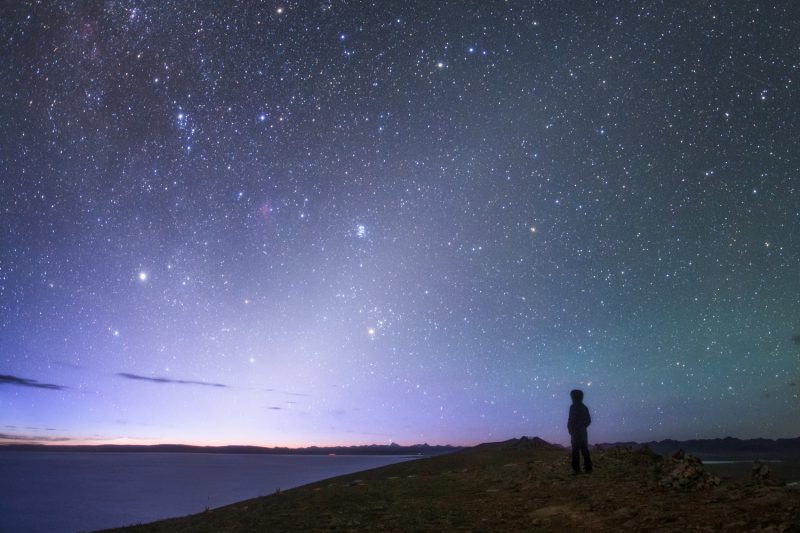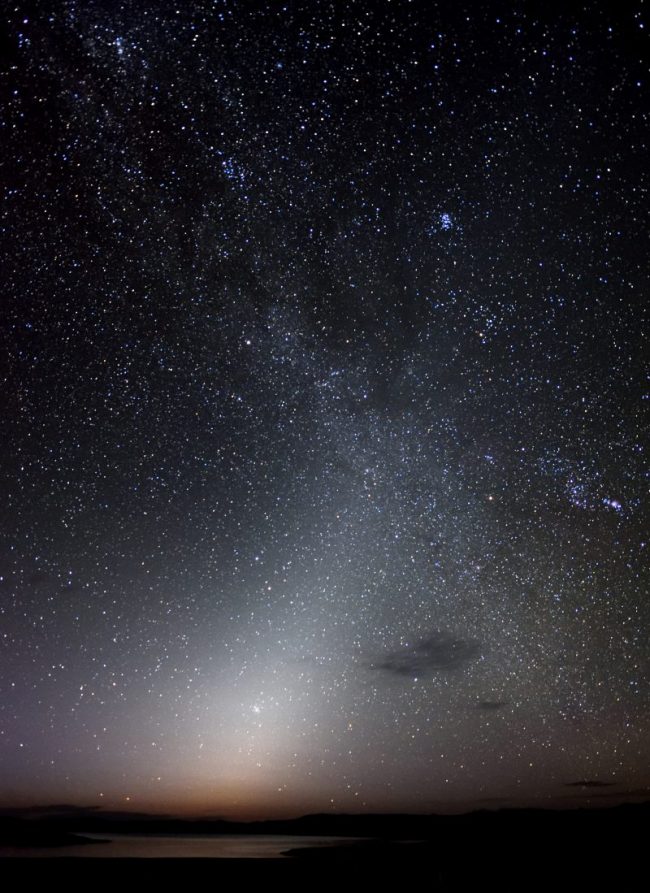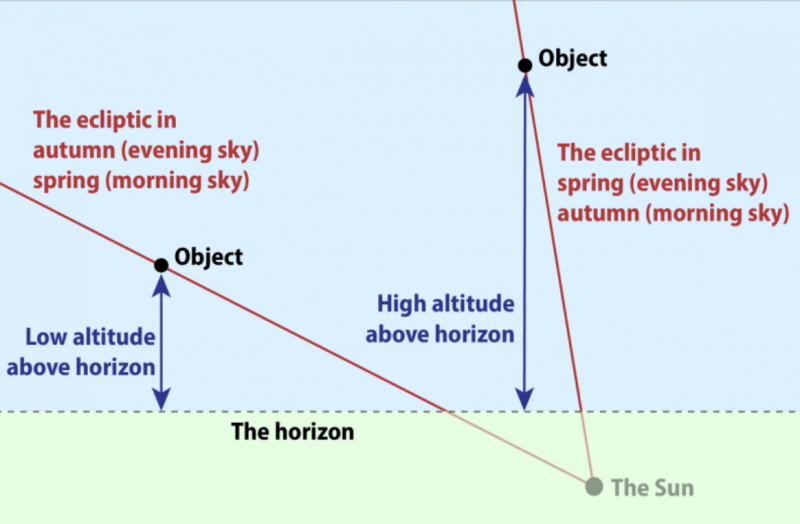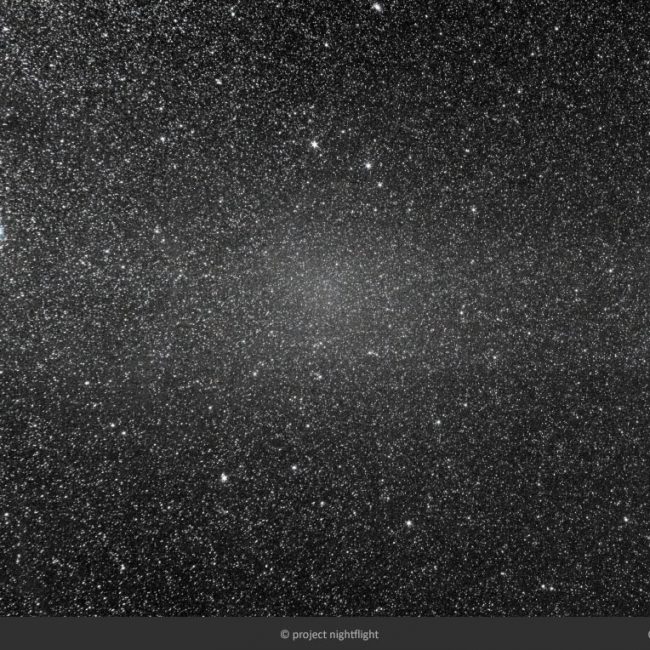
Zodiacal light is false dawn (or dusk)
The zodiacal light is a cone of eerie light above the sunrise or sunset point on the horizon. You’ll see it before morning dawn breaks or after evening twilight ends. If you’re in the Northern Hemisphere, the weeks around the September equinox are your best chance to see the zodiacal light in the east before dawn. Then it’s sometimes called the false dawn. If you’re in the Southern Hemisphere, now is the time to see the zodiacal light in the west at dusk. Some call it the false dusk.
The light looks like a hazy pyramid. It appears in the sky just before true dawn lights the sky. It’s comparable in brightness to the Milky Way, but even milkier in appearance. Unlike true dawn or dusk, there’s no rosy color to the zodiacal light. The reddish skies at dawn and dusk are caused by Earth’s atmosphere. But the zodiacal light originates far outside our atmosphere.
The darker your sky, the better your chances of seeing the zodiacal light. Your best bet is to pick a night when the moon is out of the sky, although it’s possible, and very lovely, to see a slim crescent moon in the midst of this strange milky pyramid of light. In September 2022, the best time to see that would be around September 21, 22, 23 and even 24 (new moon will fall at 21:54 UTC on September 25, 2022).

Most visible around the equinoxes
Maybe you’ve seen the zodiacal light in the sky already and not realized it. Maybe you glimpsed it while driving on a highway or country road. Suppose you’re driving toward the east – in the dark hour before dawn – in late summer or early autumn. You might see what you think is the light of a nearby town, just over the horizon. But it might not be a town. It might be the zodiacal light.

The zodiacal light is most visible around the equinoxes. That’s because the light follows the ecliptic, or pathway of the sun, moon and planets. And the ecliptic makes its most extreme angles with the horizon around the equinoxes. It makes its steepest angle on spring evenings (autumn mornings). It makes its narrowest angle on autumn evenings (spring mornings).
For the same reason, because it follows the ecliptic, the zodiacal light is often visible from Earth’s tropical latitudes. That’s because the ecliptic – pathway of the sun and moon – hits the horizon at a steep angle from this part of the world all year long.
But the zodiacal light can be extremely bright and easy to see from latitudes close to the tropics. It’s very easy to see in dark skies in the southern U.S., for example. We also sometimes hear from skywatchers in the northern U.S. or Canada who’ve captured images of the zodiacal light.
You’ll need a dark sky location to see the zodiacal light, someplace where city lights aren’t obscuring the natural lights in the sky.

Spring? Autumn? When should I look?
For both hemispheres, springtime is the best time to see the zodiacal light in the evening. Autumn is the best time to see it before dawn.
No matter where you live on Earth, look for the zodiacal light in the east before dawn around the time of your autumn equinox. Look for it in the west after sunset around the time of your spring equinox.
Of course, spring and autumn fall in different months for Earth’s Northern and Southern Hemispheres.
So if you’re in the Northern Hemisphere look for the zodiacal light before dawn from about late August through early November.
In those same months, if you’re in the Southern Hemisphere, look for the light in the evening.
Likewise, if you’re in the Northern Hemisphere, look for the evening zodiacal light from late February through early May. During those months, from the Southern Hemisphere, look for the light in the morning.

What is zodiacal light?
People used to think zodiacal light originated in Earth’s upper atmosphere. They thought it was a meteorological phenomenon (related to weather). But today we understand the zodiacal light as sunlight reflecting off dust grains that orbit the sun in the inner solar system. These grains are thought to be left over from the process that created our Earth and the other planets of our solar system 4.5 billion years ago.
These dust grains in space spread out from the sun in the same flat disc of space inhabited by Mercury, Venus, Earth, Mars and the other planets in our sun’s family. This flat space around the sun – the plane of our solar system – translates on our sky to a narrow pathway called the ecliptic. This is the same pathway traveled by the sun and moon as they journey across our sky.
The pathway of the sun and moon was called the zodiac or pathway of animals by our ancestors, in honor of the constellations seen beyond it. The word zodiacal stems from the word zodiac.

Zodiacal light and gegenschein
The grains of dust that create the zodiacal light are like tiny worlds. They range from meter-sized to micron-sized. They’re densest around the immediate vicinity of the sun and extend outward beyond the orbit of Mars. Sunlight shines on these grains of dust to create the light we see. Since they lie in the flat sheet of space around the sun, we could, in theory, see them as a band of dust across our entire sky. If we could see them, they’d mark the same path that the sun follows during the day. And indeed there are sky phenomena associated with this band of dust, such as the gegenschein, an illuminated spot possible to glimpse in a dark night sky, centered at the point directly opposite the sun (the antisolar point).
But seeing such elusive sky phenomena as the gegenschein is difficult. Most of us see only the more obvious part of this dust band – the zodiacal light – in either spring or fall.
It’s time to watch for this elusive light! We hope you see it, and enjoy it. If you do see it, let us know! And if you catch a photo, submit it here.

Bottom line: The zodiacal light – aka false dawn or dusk – is a hazy pyramid of light, really sunlight reflecting off dust grains in the plane of our solar system. You need a dark sky to see it. Northern Hemisphere dwellers look east before dawn from about late August through early November. Southern Hemisphere dwellers look in the evening in those same months. Or, from the Northern Hemisphere, look for the evening zodiacal light from late February through early May. From the Southern Hemisphere, look for the light in the morning in those same months.
The post Zodiacal light: All you need to know first appeared on EarthSky.
0 Commentaires